Albatrosses, Petrels and Shearwaters
This Seabird Photo Album comprises images of Albatrosses (Diomedeidae), and Petrel/Shearwaters (Procellariidae) photographed in pelagic and coastal habitat. See Taxonomy note at the end of this page. The first of three galleries feature bird portraits, the second birds-in-flight and the last bird behaviour. I’ve included birds in flight because these species spend a significant amount of their life on the wing.
The galleries contain some digitally scanned images that I captured on slide film.
Albatrosses, Petrels and Shearwaters
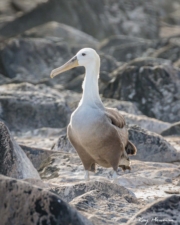
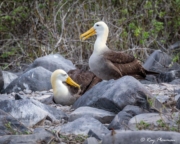
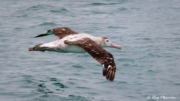
Albatrosses, Petrels and Shearwaters Notes
Seabirds roam the oceans far out at sea and only come to coastal areas to breed and raise their young, thereby offering great photographic opportunities. Kaikoura pelagic in New Zealand is one of the best places to photograph albatross endemics and other seabird species.
Most seabirds drink salt-water, filtering excess salt from their bloodstreams. They use salt glands located in their head above the eyes and excrete excess salt from the nostrils, which then runs down the bill and drops off at the tip. Albatrosses and related shearwaters and petrels have pronounced tubular nostrils on either side of the top of their beak, therefore called tubenoses making then instantly recognisable.
Shearwaters spend daylight hours at sea and return after dark to their nest burrows to feed their chicks.
Red List (2019) of Threatened Species
There are twenty-four albatross taxa: fifteen ‘Threatened’, six ‘Near Threatened’ and only one ‘Least Concern’. Displayed in the gallery are six species, five ‘threatened’ and one ‘Near Threatened’. All the following are breeding endemics:
(a) ‘Critically Endangered’ Waved Albatrosses on Espanola Island in the Galapagos.
(b) Three ‘Endangered’ New Zealand are the Antipodean albatross, Gibson’s Albatross, and Northern Royal Albatross.
(c) The ‘Vulnerable’ Salvin’s Albatross in New Zealand.
(d) The ‘Near Threatened’ White-capped Albatross in New Zealand.
Petrels and Shearwaters fair a little better with forty-three ‘Threatened’, eleven ‘Near Threatened’ and forty-one ‘Least Concern’. Except for the ‘Endangered’ Westland Petrel and ‘Vulnerable’ White-chinned Petrel, other petrel and shearwater species shown in the gallery are ‘Least Concern’.
The conservation status reflects the poor state of our oceans.
Albatross and Petrels Inflight
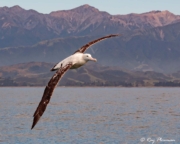
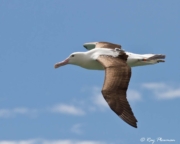
Tubenoses Inflight Notes
The gallery shows images of tubenoses inflight. Where possible, I’ve included two photographs of each species to show over-wing and under-wing plumage.
Albatrosses spend much of their life on the wing while petrels and shearwaters can fly long distances in search of food.
Albatross and Petrels Behaviours
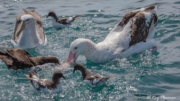
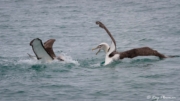
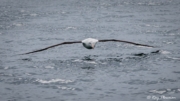
Albatross and Petrel Behaviour Notes
When birds compete for the food, they often exhibit threat behaviour or become aggressive, providing excellent photo opportunities. The first image shows a fur seal eating a fish with white-Capped Albatrosses looking for a share. Other photos in the gallery show a feeding frenzies and threat behaviours of several albatrosses and petrels.
Shearwater Behaviour
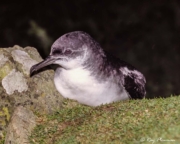
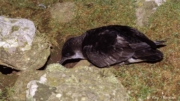
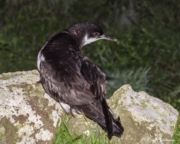
Shearwater Behaviour Notes
In the mid-nineties, I photographed Manx Shearwater (Puffinus puffinus) in their breeding colony on Skomer Island. The images are digitised scans from colour negatives and positives.
The gallery shows birds at or near their burrow entrances, on the ground or perched on rocks, in total darkness. To avoid predators during the day they are either at sea or in their burrows below ground. At night, these clumsy birds waddle and drag themselves to a high point then launch themselves into the air. The Great Black-backed Gull is a successful predator and judging by the number of dead birds and carcasses; they are easy prey.
Staying on Skomer at night is a marvellous experience, this is when the birds become active, very noisy and seen above ground. There is little ambient light on Skomer, making photography and walking around the island a challenge.
Manx Shearwaters arrive on Skomer in March. The colony has an estimated population of 120,000 breeding pairs, and on nearby Stockholm, another 45,000, estimated world population is 350,000 to 390,000 breeding pairs. I visited the island in June and July when all the nesting seabirds are most active busy feeding their chicks. In late August, the adult Manx Shearwaters abandon their young, leaving them to fend for themselves. After about a week the young leave the island, navigate on their own to overwinter off southern Brazil and Argentina.
I’ve included another shearwater victim of predation; the Short-tailed Shearwater photographed at Griffiths Island in Victoria. Linked by a causeway allows introduced predators like fox onto the island.
Albatrosses, Petrels and Shearwaters Taxonomy
The Seabirds Photo Album webpage describes the higher-level taxonomy for these families. The tubenoses comprise Diomedeidae (Albatrosses) and Procellariidae (Petrels, Shearwaters) families placed in the Procellariiformes part of Aequornithes (Core Waterbirds) clade.




































